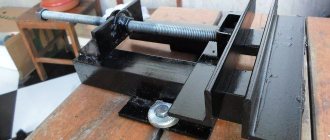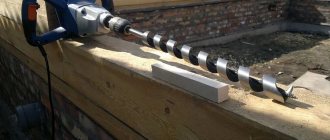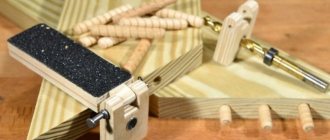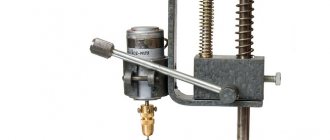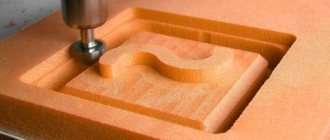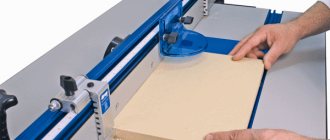First, let's figure out what a furniture jig is? Every time, assembling some kind of furniture, the master performs many completely identical marking operations (for example, marking 20 minifixes when assembling a cabinet means marking three completely identical holes with the same indentations). So, a jig is a device that allows you to optimize the processes of marking and/or drilling.
There are two main types of jigs : marking and drilling . If the former serve to simplify marking, then the latter allow you to completely remove this stage from the work, starting immediately with drilling holes. Looking ahead, I will say that it is better to have both types.
Naturally, good conductors cost money, so people get rid of them and come up with their own homemade versions, which are often no worse than factory ones.
Let's look at a few examples.
Marking furniture conductors:
Homemade conductor from a ruler. Probably the simplest and at the same time quite convenient and multi-purpose marking jig, which I recommend making. It is a ruler with a cross member screwed to it STRICTLY PERPENDICULAR. The ruler has holes drilled at certain distances from the beginning (for example, 32 mm for minifix, 100, 200, 300 mm for shelf holders, etc.)
Alternatively, you can use a ready-made carpenter’s square as a basis for such a jig (this is exactly what I have). It has its advantages (greater functionality) and disadvantages (less stable on the workpiece).
In addition, it uses highly specialized jigs, for example, for marking holes for furniture handles .
For marking furniture hinges, this is a factory jig, but who’s stopping you from making the same one?
In general, using several pieces of plastic, metal and even plywood, you can make a simple marking jig to suit your needs.
The professional marking conductor Assistent is a serious multi-purpose device. (I haven’t worked with it myself, but it seems to me that you can drill through it - it all depends on the bushings used).
Drilling jigs are more complex devices. The hole in them must not only be clearly opposite the desired location, but also be strictly perpendicular so that the drill does not go to the side during operation (for this, for example, replaceable bushings of different diameters are used or the thickness of the jig must be at least 10 mm).
The dubel-profi jig from KVB is an excellent household drilling jig (for amateurs), which comes with a bunch of accessories (rulers, clamps, etc.), is inexpensive and simplifies the work. I have two.
Professional drilling jigs. I think that the principle of operation is quite clear from the photo. Replaceable bushings – for drills of different diameters
Another option is a condor conductor. It has a system for positioning the jig on the workpiece and replaceable bushings.
Again, to suit your needs, you can make conductors of similar functionality with your own hands.
In short, the topic of conductors is almost endless))). To each his own and for his own. The main points, as I think, I have depicted - then it’s up to your pocket and/or ingenuity.
You can make maximum and precise holes in products based on natural wood, metal, MDF or chipboard using a special jig. This is an indispensable thing for those who produce furniture; such a device is also needed in other areas.
Such a conductor can be purchased ready-made, or you can make it yourself.
Features of application in the furniture industry
Conductors and templates are needed when assembling furniture. These things will prevent you from having a common problem that occurs during drilling—the drill hitting the part at the wrong angle. Correcting such an error will take an extremely long time, in some cases it will even be impossible.
A jig for making holes will not only allow you to correctly orient the working tool, but will also prevent it from straying from the desired trajectory.
In the furniture industry, jigs and templates are used in the following cases:
- in mass production;
- when assembling structures, when it is necessary to make holes for fasteners in the parts being connected. In this case, a jig for drilling holes for dowels or confirmat is suitable;
- a jig for drilling holes at an angle is used both in such cases and when working with thin boards, for example, MDF or chipboard.
When using such a device, the assembly process will be much easier and faster; you will be able to make the necessary holes regardless of how far they should be located from the edge of the part and how wide it is.
When assembling furniture yourself, you often have to connect parts end-to-end using dowels. Holes for dowels are best made using a special jig. The peculiarity of dowels is that despite the fact that such fasteners, although outdated, are still relevant in furniture production.
The difficulty in their use lies in the fact that the axes of the holes that are made in the parts when connecting must have a right angle with each other. Accordingly, they must be placed strictly perpendicular to each other. It is difficult to do this without a special device. Therefore, if you want to achieve high quality performance, it is recommended to buy a dowel jig.
Communities › DIY › Blog › Tools for assembling furniture (personal experience).
In yesterday's topic about building cabinets, a lot of people asked to tell us what tools my friend and I used to assemble the furniture.
I believe that professionals will not be interested in this, and many will even say that they could have made the templates themselves and not spent money. It is possible, but without experience, it is difficult and time-consuming. We took the fast, but costly, route - we bought ready-made ones. However, I am very grateful to everyone who sent me drawings of their templates - it really helped me understand the topic and understand what's what.
In general, as I understand it, two approaches are used to connect chipboard using confirmations: 1) Templates for drilling end and front holes. They can be in the form of rulers (like Cheron) and in the form of drums. They can also consist of entire systems that are attached to a sheet of chipboard. But the general idea is that each sheet is drilled out one at a time. Perhaps you can save time and use another method. 2) Clamps for fixing chipboard sheets at the desired angle (usually 90 degrees) and a confirmatory drill. The advantage of this option is that in one pass we get both holes at once and can immediately tighten the confirmation. It would seem that everything is easy and simple, but now try to combine panels with a length of 2600 and 1200 mm at an angle in an apartment. Hard? running away? yes, and not alone at all (not like in the first option).
Other uses
Hole jigs are used not only in furniture production. Quite often they are used when you need to make a hole in a pipe or other cylindrical part. Thanks to them, you can make a high-quality hole even in a pipe with a small diameter.
Read also: Selecting cutting modes when milling
Such devices are universal and easy to use, so they are also used in the following industries:
- mechanical engineering - drilling holes in different-sized workpieces based on different materials;
- construction - drilling holes in building structures;
- home communications - as already mentioned, pipe drilling and more.
Modern drilling jigs can be of different sizes and have different operating principles. Some of them are complex, so they are easier to buy. And some modifications can be made independently, especially since some serial furniture models, especially those with universal purposes, are expensive.
Template characteristics
Installing furniture hinges is an important step in assembling cabinets. A special insert template is used for this process. This element is made from different materials. You can purchase a ready-made part in a store or try to do everything yourself.
Work on installing facades is simplified by templates for furniture hinges. The finished element has many advantages. These include convenience, since there is a sketch for marking. Among the advantages of using a template are the strength of the structure, ease of use, and compactness of the product.
Benefits of use
Essentially, such a jig acts as a template for making holes so that they are made as accurately as possible. They can be used for those holes whose axis is perpendicular to the surface of the workpiece, as well as for working at an angle.
This tool is an excellent alternative to sketches and manual measurements. You can place the drill strictly at the desired angle in relation to the workpiece and will not allow any deviation. The result will be especially noticeable when it comes to making deep holes.
If you use such a high-quality device for working with chipboard, then it should have the following characteristics:
- facilitate quick assembly of furniture without the need to use complex tools;
- make it possible to make several holes simultaneously without manual marking;
- significantly improve the quality of work with the drill.
Conductors are made from different materials; there are models based on plastic or organic glass. However, the best option is considered to be made of steel , which has such advantages as:
- minimal likelihood of deformation;
- the drill is directed as clearly as possible;
- no heating during operation.
Very often, overhead models based on lightweight materials that are easy to manipulate are used as furniture jigs. Many people use factory or homemade tools.
And the most qualified and experienced craftsmen no longer use a jig, since they can easily make a hole in structures on their own as accurately as possible. But not everyone can do this.
The key advantage of such a device is that the work can be performed as accurately and efficiently as possible, even by a person who does not have the proper experience. You don't have to do markings and complex preliminary calculations. You will save a lot of time and produce furniture much faster.
Selecting a model for production
Conductors of industrial production can be highly specialized and universal. Templates of the first type are used to perform certain operations on typical parts. Universal devices are suitable for working with different materials and objects of various configurations.
Based on design features and functionality, conductors are divided into the following types:
- overhead - when used, they are applied to the surface in the desired area, fixed with clamps or held by hand. Used for drilling holes in flat parts;
- rotary - the working part moves in both vertical and horizontal planes. Used when working with elements of complex geometric shapes and to create holes, the axis of which must be located at an angle;
- tipping - used to create holes in perpendicular planes.
A marking jig is used to mark the locations for drilling holes. It is much thinner and lighter.
The conductor device can be specially created for a certain type of fastener: dowels, confirmations, screws, corners. There are devices to simplify the process of installing fittings.
According to the type of fixation, furniture jigs can be sliding or fixed. The former can be moved freely over the surface if necessary, while the latter are rigidly fixed in the right place. The presence of an adjustment mechanism will help to combine the device with different types of workpieces.
For large furniture manufacturers, the availability of a variety of additional accessories plays a decisive role, since they significantly reduce time costs. In this case, the cost of the tools does not matter much. A completely different approach to purchasing the necessary equipment from those who have a small furniture production facility or from independent craftsmen who produce certain types of furniture. In this case, making furniture templates with your own hands turns out to be much cheaper and more practical. The choice of the necessary options and the complexity of the device are determined not only by production needs, but also by the skill and experience of furniture manufacturers.
Classification of tools
Before you buy a ready-made conductor or make it yourself, you need to decide what problems you will solve with its help and only then you need to select the appropriate option in terms of design and functions.
There are a number of categories of devices that differ in their design and functional features. Here are some of them:
- overhead - such devices are applied to a part that can be processed, then it is attached to it or simply fixed manually. With their help, holes are made in various flat parts, MDF boards or chipboard;
- rotary - these templates are used when processing cylindrical parts. They are equipped with horizontal and vertical axes of rotation, so holes can be made at different angles;
- universal - such devices are suitable for small serial furniture manufacturers, where sometimes quick readjustment of the equipment used is required, they have all the functions necessary for this;
- tiltable - used when the technological procedure is carried out in several planes at once;
- sliding - such conductors do not need to be attached. Simply attach them to the surface area of the workpiece where you want to make a hole;
- fixed - they are more convenient to use, but they limit freedom of action, which is very critical when working with machines where there is only one spindle.
Features of drawing up a drawing
You can make a template yourself if you have a drawing of the future design. To develop a sketch, you need to know what elements the template consists of.
Template structural details:
- Base. There are holes for drilling on it. This part of the furniture hinge installation template is key.
- Holder. The functions of an element include a limitation. The part is fixed to the door leaf, thereby eliminating shifts and deformations.
- Connecting parts. These elements help to adjust the template to specific door hinge sizes. The number of connecting elements depends on the complexity of the structure and the functions assigned to it. The primitive template has only 3 such details.
You can determine the amount of materials needed if you accurately determine the dimensions of the template. The design can be made more complex. You can add the installation of door locks to the functionality of the template.
DIY jig for drilling holes
As already mentioned, depending on the scope of use and design, you can make some options yourself, thanks to which you will save a significant amount.
Before work, find the required drawing of the device and make everything strictly according to it.
Tools required for work:
- welding machine;
- Bulgarian;
- drill;
- locksmith supplies.
To make the simplest version of the conductor with your own hands, we perform the following steps:
- take reinforcement measuring 10 by 10 mm with a square cross-section;
- cut a piece of the required length and sand it with sandpaper;
- make markings for the template holes. In this case, it is not allowed for the center to approach the edge by more than 8 mm, this is almost half the thickness of the chipboard sheet. Also, according to the standards, a distance of 32 mm must be maintained between centers;
- after marking the centers, make holes in them 5 mm in diameter;
- to make an emphasis, take a metal plate 2.5 mm wide and 1 mm thick. Bend it at an angle of 90 degrees, and then, together with a piece of prepared reinforcement and fastening in a clamp, make a place for the thread;
- cut the thread and connect the two parts into one structure. The device is ready.
As you can see, such a device is very simple to make yourself, but it will greatly simplify your work if you are making furniture. If you are doing this exclusively as an amateur, then this option will be sufficient. If you can’t do it yourself, buy a ready-made option, perhaps the simplest and most inexpensive.
But professional equipment will cost much more; it makes sense to purchase it even when we are talking about at least small-scale mass production. But with its help you can easily and quickly connect pieces of furniture or repair it.
So, you have learned what a hole jig is and how it helps in furniture production. This device can be purchased ready-made or made by yourself.
Read also: Multiplaz 2500 instruction manual
A drilling jig is an indispensable attribute in large-scale production, no matter what kind. Where there is a lot of drilling, it is really necessary, especially when production is serial or mass.
With the help of a conductor, production is greatly accelerated and the worker's work is made easier.
What is system 32 in the installation of furniture fasteners and accessories
In the production of cabinet furniture, they are increasingly moving away from standards, implementing some individually developed projects. However, there are certain design principles that remain unchanged. And at the international level.
Furniture system 32 is a general principle for standardizing the layout of furniture for further assembly. Its basis is a repeating step of 32 between the centers of the mounting holes with a distance of 37mm from the edge (taking into account the thickness of the edge).
System 32 is also followed by manufacturers of various furniture fittings and components. Thanks to this, the furniture maker does not have to think about and measure different distances in order to install guides for drawers of different types, handles of different sizes, lifting mechanisms, furniture hinges, etc. It is enough to remember a simple series of numbers (with time and growing experience in making furniture with your own hands, it is remembered like a multiplication table).
All this saves time and costs for the manufacturer in preparing furniture for assembly. System 32 also “subordinates” the settings of CNC machines, drilling and additive equipment.
Jig for drilling holes
A drilling jig, as a rule, is a bar (plate) with holes and bushings (sleeves). Using a jig it is much easier, for example, to drill pipes.
As for furniture production, they are also used here, although relatively recently.
With the help of such equipment, the manufacturer is relieved of the following problems:
- Marking.
- Punching (point depressions in the material for a drill).
- Drilling while maintaining perpendicularity.
The latter is especially difficult to achieve, since it requires serious skills acquired only over the years.
Some operations, for example, drilling for dowels (short wooden rods designed for hidden joining of parts), require very precise markings, and no less accurate drilling at an angle of 90°.
With such a device as a conductor, these tasks are solved easily and simply.
Types: choose the one you need
Invoices. They do not require fixation before being used for their intended purpose. Structurally simple, mobile, but they need to be held with a hand free from the drill, since often the equipment is not secured in a special device, which is not very convenient. Considering the simplicity of the design, making it yourself is quite simple. Used when drilling chipboard and MDF.
Jigs for drilling holes at an angle. The design is easy to imagine, since the name speaks for itself. Such equipment can also be an overhead one. In the production of high-quality furniture, there is also drilling at an angle, which is not the simplest operation in the production process - this requires skill. Although in this case, sometimes the required angle is violated, as a result the assembly will not be of such high quality and the appearance of the furniture will suffer, especially if it is not made of chipboard, but of wood - here you can’t fill in an ugly drill. Equipment of the required design completely eliminates unnecessary problems.
Rotary conductors. They have folding brackets, and this allows drilling on two adjacent planes.
Sliding gearboxes. With their help, you can drill several holes without reinstallation. To work with such equipment, the necessary skills are still required.
Making your own template
Making a template for furniture hinges with your own hands follows a clear plan. It is important to follow the sequence of steps. If you follow all the rules, then no difficulties will arise in the process.
Stages of developing a template for loops:
- Selection and preparation of materials;
- Preparation of necessary tools;
- Development of template details;
- Final assembly of all elements.
Paper template for download
- To create a template yourself, you need to print a sample.
- According to its dimensions, make a blank from solid material, plastic or wood
- Attach the paper template to the workpiece
This is what you should get.
To create a workpiece you will need to take a drill, router, hammer, and jigsaw. You will also need tools for drawing markings. First you need to make a base. The optimal dimensions are 19x38 cm. A hole measuring 13.5x7 cm should be made in the center. The edges should be smooth. A router will help with this.
Bolts must be placed on the workpiece. It is important to maintain symmetry relative to the width of the base. The bolts must be buried in the structure so that they do not interfere with further manipulations. The hole is made wider than the connecting elements and additionally driven in using a hammer.
It is necessary to retreat 7 mm from the 13.5x7 cm holes and make small notches. Around an element with dimensions of 37.5x7 cm, notches are made on one side at a distance of 30 cm from each other.
A homemade template requires a holder measuring 2x5 cm and a length of 5.8 cm. You will need to install a limiter on one of the sides, which looks like a small block. This element will not allow the distance to shift when installing the facade.
Then all parts of the template are attached. Washers are installed under the bolts and nuts. This element increases the durability of the template. The manufacturing process does not require special skills or knowledge. It is enough to familiarize yourself in detail with the template development scheme.
Selection of materials for work
For the template, you can use plywood, chipboard or MDF. More durable structures are made of plexiglass and metal. You can take several materials for one template. So you can use chipboard for the base, and make the guides from a more durable material. It is easier to work with wood, as it is easier to process than glass and metal.
Required connecting elements:
- Bolts. You will need 6 pieces with a thickness of 6 mm and a length of 30 mm. To fix the connecting element, you need to have a 10 key.
- Nuts. Need 6 pieces. The main requirement for the element is convenient adjustment. Wing nuts are most often used.
- Washers. Their diameter should be 6 mm.
- Self-tapping screws. They are selected depending on the thickness of the remaining connecting parts.
Device for drilling holes for dowels and confirmats
Despite the fact that today a lot of new accessories have appeared in the furniture industry, the good old dowel is still used. This is explained by the fact that the connections are not visible through this piece of fittings, and this is especially valuable in the production of furniture made from natural wood.
As already mentioned, drilling for dowels creates many problems for furniture makers, especially those who are not sufficiently qualified.
In order for the furniture planes to be perfectly aligned, precise markings are necessary, and this equipment allows you to speed up the work and bring the quality to the desired level.
Working with confirmats - special furniture screws - although less troublesome, also requires certain skills. And considering how many holes need to be marked and drilled before screwing the confirmation into one piece of furniture, such a device will significantly speed up the work, and its quality too.
The simplest devices
- The conductor is two-slider. It allows you to drill holes in two adjacent (mating) parts. The device is constructed of two rulers, which serve as guides and are connected to a mounting strip. The holes made in it make it possible to install the strip on parts of different widths. Housings moved along rulers (replaceable) have a set of guide bushings, where the distances between them are different. The conductor is fixed by means of a connecting strip, and on the opposite side there is a travel limiter, pressed by a thumbscrew.
- The conductor is multi-position. Fastened with clamps. The design allows for vertical drilling. It is made of thick-walled aluminum angle. Since the device is quite long, it is equipped with an intermediate fastening in the center of the structure. The thick wall of the angle was used very successfully, which cannot be overestimated at the moment of placing the device on the surface of the part and when reinstalling the jig to 90°. The selection of the distance between the bushings is carried out according to the most common values provided for installing dowels or confirmations.
Procedure for working with a conductor:
- The device is fixed on the workpiece.
- The sleeve is inserted into the hole.
- Drill through the sleeve.
Blum furniture fittings: price, reviews, where to buy, how to set up
If you look at the assortment, then all factory or factory conductors can be divided into 2 categories. These are universal and highly specialized devices. The first type of template is suitable for performing various tasks, working with standard furniture elements. They can be used when drilling different materials and performing all kinds of operations. It is the universal models that have become widespread in everyday life and among those who assemble tables with their own hands and make original designs.
In particular, I recently had to deal with the creation of a manicure table. I also have plans to try to assemble a table with a hiding place myself. Everything is still at the design stage, but there are interesting ideas. In many ways, I reflected my observations in the material at the link.
Conductors can be classified depending on their design features and functionality.
There are actually 3 main varieties here. These are the ones home craftsmen should pay attention to.
- Invoices. When working with a conductor, you need to attach it to the material at the desired point, fix it with a clamp, if there is one, or hold it with your hand. Suitable for drilling flat parts;
- Rotary. Here the working part can move in a vertical and horizontal plane. An indispensable jig if you need to drill elements with a complex geometric shape, as well as for holes at an angle;
- Tiltable. This is an option for situations where you have to drill in a perpendicular plane.
There is a category of conductors that are designed for specific tasks and work with certain fastenings. This includes tools for dowels, for confirmations, corners, screws, etc. There are also solutions that are used for installing fittings for cabinet furniture and more.
DIY furniture jig: drawings with dimensions to help
The principle of this equipment:
- Angular housing. It is superimposed on the planes of the parts, which will then be connected to each other.
- Guide bushings. The drill will go through them.
- Clamping devices. They fix the conductor and are made from the end part.
Designing your own jig should be based on the fact that with the help of this equipment it is possible to do most of the work performed related to various types of fasteners.
Important! If you need a universal assistant - this applies to professional furniture makers, then it would be better to purchase industrial equipment that is made more accurately and with high quality. It is this kind of device that will be preferable and will quickly pay for itself, especially if you also take into account the fact that this device often comes with many different templates, stops and other little things that are also necessary in the work. They are much cheaper than buying at retail.
And yet this device, if necessary, can be made with your own hands.
Such equipment may not be needed very often in any given industry, and even more so for a home craftsman. So for many users it will be much more profitable to do it themselves.
If the design of such remains relevant, then you need to prepare materials for the manufacture of a homemade conductor for drilling for confirmation:
- Corner. Your choice should be made on the unequal type of this rental - its possibilities are wider. The corner shelf must be chosen with the greatest thickness, which can reach up to 8 mm. This is quite justified, since then it is possible to insert guide bushings with an outer diameter of up to 6 mm. Based on this, you can use drills from 3.5 to 4 mm. Even if that diameter is not enough, then the material is drilled out with a large drill, without using any other devices.
- Guide bushings. Here, stainless steel pipes will be preferable, which are selected primarily by internal diameter. Example: a 6×1.5 pipe is suitable for a drill no larger than 2.7 in diameter. Explanation: its internal hole will be 3 mm, and a small gap along the entire internal diameter is taken into account due to thermal expansion of the material. The length of the sleeve is the depth of the hole in the corner, multiplied by two or more. The fit of the bushings is either transitional, or with an interference fit, or according to the shaft system. The latter is the most appropriate.
Read also: Should a resistor ring?
Instead of pipes, of course, you can use ready-made bushings used in wire drawing machines - these are available, for example, in mechanical engineering. Such parts (even used ones) come in handy: they are made of alloy steel and have an almost unlimited service life.
Choosing a mounting method
- Fixation using self-tapping screws. They are screwed into the part, which prevents the device from moving due to friction. This is convenient because these marks will be needed for subsequent drilling of other holes.
- Spring stop. It will securely fix the jig to the part. For such a stop, a flat spring with an appropriate clamping force is suitable.
- External clamps. Rubber pads must be placed under them. Corrugated rubber is ideal as a material. This, of course, slightly increases the weight of the equipment, and the elasticity of the pads can negatively affect the perpendicularity of the bushings. To prevent this from happening, the drill is inserted into the sleeve to mark the hole, and only then the clamps are clamped.
Homemade conductor devices
Jigs of the simplest design, for example, those used for drilling holes for confirmation, are relatively inexpensive, so many craftsmen do not bother making them themselves and purchase serial models. Meanwhile, there are those who try to make even such simple devices with their own hands. The question of how to make a jig for drilling with your own hands often arises and, if necessary, drill non-standard holes.
To make your own jig for dowels or a jig for confirmations that is simpler in design, you can use drawings and videos on the Internet.
When manufacturing a jig, you will need perfectly accurate drilling of guide holes and hardening of the finished device
To manufacture such a device, naturally, you will need a drawing of it. You also need a minimum set of tools and equipment:
- electric or hand drill;
- a set of locksmith tools;
- Bulgarian;
- welding machine (for the manufacture of jig devices of a more complex design).
For drilling pipes and cylindrical parts
Modern furniture uses not only chipboard, fibreboard, MDF and wood. Steel pipes of various diameters can be used as additional elements. Covered with chrome or stainless steel, they perfectly complement the overall furniture ensemble.
It is very difficult to drill a spherical surface - the drill tends to slide to the side. And it’s not so easy to mark when there are a lot of holes and they are located in several rows.
In order to ensure that the pipe does not turn out to be the notorious colander, but a correct part with precisely made holes, you will need a jig - this is the ideal solution in this situation.
There are steel conductors made in the form of an adjustable clamp. This design feature allows you to clamp pipes of different diameters into them and drill holes in them with high precision.
Not being able to make such a device, you can use waste materials, making an even simpler device using a block and a strip of plywood. Thus, a block cut diagonally along a circular saw can be nailed or screwed with screws at an angle of 90° to the plywood. The resulting device is placed on top of the pipe, and a strip of plywood, resting against a table or workbench, prevents the specified angle from being violated. Holes of the required diameter pre-drilled in the block are placed taking into account the required distances between future holes, which will allow you to quickly and accurately drill the pipe exactly according to the drawings.
DIY furniture conductors and templates
How conductors are made is now clear, as is their necessity for furniture production.
Not only conductors, but also templates are needed in furniture production. The simplest template will sometimes save a lot of time and allow drilling to be no less accurate than a jig.
For example, the simplest metal prefabricated template, consisting of two sheet blanks measuring 130x70 mm and a steel square with a cross-section of 20 mm. They are connected to each other by screws at the top of the structure - this is how they are attached to the square. The square is drilled for the bushings, where the latter are pressed. Such a device for drilling holes in the end of a part made of chipboard will make it possible to drill without thinking about marking and perpendicular drilling. And the price of this equipment is below any idea of savings.
Instead of metal, you can and should use those materials that are inexpensive and easy to process.
- Plywood.
- Textolite or fiberglass - preferably thick.
- Hardwood.
- Hardboard or its equivalent.
It must be borne in mind that these materials are short-lived, and so that the devices do not have to be made every day, it is quite reasonable to press metal tubes into them.
In conclusion, it is worth summing up what has been said. Making a conductor or template yourself or buying it in a store is a matter for everyone individually. If a home craftsman needs to make some furniture in a single copy and there is material for a conductor, as well as the possibility of making it, you can use this. It is possible that such equipment will never be useful to the master again.
But if even a small furniture workshop is engaged in the production of mass-produced furniture, and it employs enough people, it is probably easier to purchase something ready-made, especially since they will need these indispensable assistants to the craftsmen in several copies.
In the latter case, it makes sense to purchase more expensive, accurate and wear-resistant jigs instead of making homemade ones, which are less accurate and durable.
Washing machine in the kitchen: installation options, reviews, pros and cons
Furniture jigs are fairly simple mechanical devices. They are needed in order to simplify and speed up the process of drilling various holes. Using such an object, you can make a hole according to the markings and with optimal accuracy and the required angle of inclination. It is actively used in the process of assembling furniture and when performing various carpentry tasks. The conductor is perfect for household use, since you can always do it yourself or purchase a small tool for personal use.
In essence, we are talking about a template for holes with different diameters. The main part of the tool is presented in the form of a rectangular block made of durable material. There are holes on the block.
To simplify work with the conductor, many models are equipped with additional adjustment and fixation mechanisms. If desired or necessary, you can make the tool yourself. And sometimes the result turns out to be no worse than Cheron.
With the help of a jig, the drill moves in a given direction and creates a hole of the required size. In this case, the material is drilled strictly at a right angle of 90 degrees. Some models allow you to adjust the angle or they initially have a certain inclination. It is extremely important to eliminate deviations when processing thin materials, the end parts of doors and walls. It is difficult to maintain the correct angle manually. Often there is a lot of waste, and you have to waste extra material.
The jig is designed for drilling all materials used in furniture production, including wood. Chipboard and MDF.
If you need to make many identical holes on different parts, or make them perfectly straight along one line, the jig will become simply an indispensable device.
